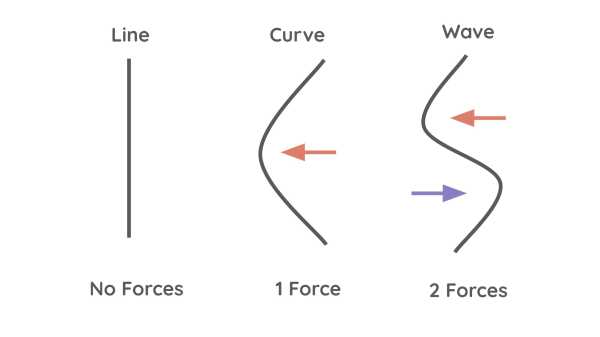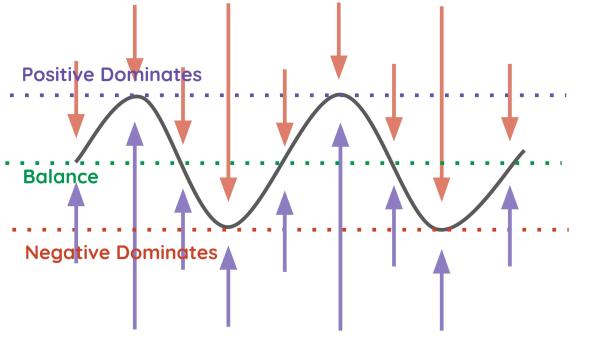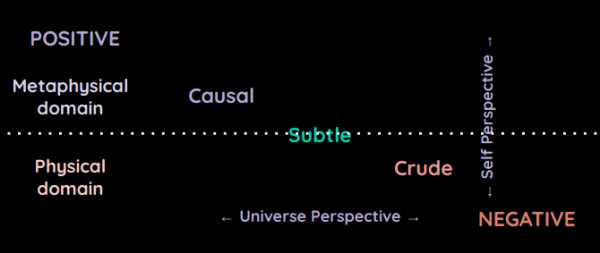The 3 Operational Divisions of Reality
Table of Contents
The first section explained how the 2 domains are static divisions of Existence, based on immediate perception as physical or metaphysical.
Section 1c explained that reality is the part of Existence which is made up of waves that are never static.
These waves are caused by the fight between the Positive and Negative Forces.
- 0 forces do not disturb the line of cognition
- 1 force creates a disturbance as a curve
- 2 forces creates a disturbance as a wave

Causal, Subtle, Crude within Physical and Metaphysical
The clash between of the 2 equal Forces creates a middle point each time they interact. This creates 3 parts within the interaction:
- Positive Dominant
- Neutral or Balanced
- Negative Dominant

It can be easily noticed how the balance part has the most number of instances compared to either dominant parts. This is why the Middle Path is advocated by Buddhism and Taoism.
This is opposed to:
- the extreme renunciation of Hinduism
- the extreme materialism of Capitalism and Communism (as Dialectical Materialism)
These 3 parts lead to the 3 operational divisions of reality as:
- Causal
Here, the Positive Force dominates
- Subtle
Here, the 2 Forces are in Balance
- Crude
Here, the Negative Force dominates

The ability to think has several degrees.
- The speculative intellect
- The experimental intellect
- The first degree.. mostly consists of perceptions.
Ibn Khaldun
Muqaddimah
This is similar to the Freudian divisions of the mind as:
- Unconscious
- Subconscious
- Conscious
However, our difference is that the basis for the divisions are not awareness, but the properties of the 2 Forces of Positive and Negative.
- This is the same basis of the 2 domains.
The interaction of different phenomena take place in 3 divisions based on their affinity with either the Positive or Negative Forces.
A static non-moving solid object get its staticity from the dominance of the Negative Force.
- This principle is the basis for freezing photons to be used for light-based computing to bypass Moore’s law in transistors
Basis for the Groupings of Phenomena
These divisions are the basis for different groups of phenomena:
| Division | Phenomena |
|---|---|
| Causal | Abstract |
| Subtle | Living |
| Crude | Non-Living |
Each of these divisions have its own subdivisions made up of 5 parts.
| Division | Subdivision |
|---|---|
| Causal | 5 Strata |
| Subtle | 5 Elements |
| Crude | 5 Layers |
- The 5 parts of the causal subdivision is called the 5 Strata
- The 5 parts of the subtle subdivision is called the 5 Elements, with reference to the Asian 5 Elements
- The 5 parts of the crude subdivision is called the 5 Layers

These phenomena and subdivisions will be studied by the different branches of Superphysics.
| Subdivision | Phenomena | Superphysics Branch |
|---|---|---|
| 5 Strata | Abstract | Social and Spiritual |
| 5 Elements | Living | Bio |
| 5 Layers | Non-Living | Material |
Static is 3, Dynamic if 4
The 3 divisions arises from the static view of a symmetric thing: it will have a center and 2 extremes.
- These 2 extremes are represened by the Negative and Positive Forces.
These 3 divisions also manifest as the basis for the 3 Gunas of subelements within each Element, to be explained in the next Chapter.
The 4 divisions, as explained in the 4 properties of waves, arises from the dynamic nature of those 2 Forces, as high-low going to low-high and vice versa.